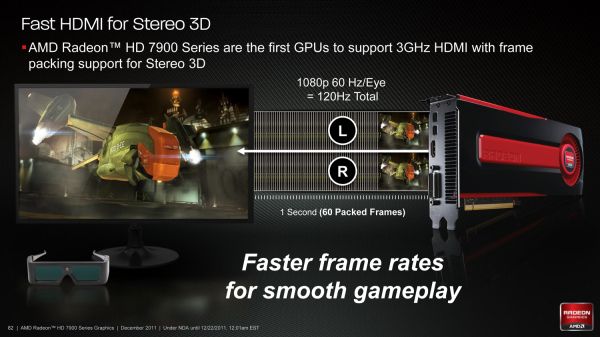AMD Radeon HD 7970 Review: 28nm And Graphics Core Next, Together As One
by Ryan Smith on December 22, 2011 12:00 AM EST- Posted in
- GPUs
- AMD
- Radeon
- ATI
- Radeon HD 7000
Display Tech, Cont: Fast HDMI
Moving on from multi-monitor applications, AMD has not only been working on technologies for multi-monitor users. Southern Islands will also include some video and movie technologies that will be relevant for single and multi-monitor uses alike.
With the 6000 series AMD upgraded their DisplayPort capabilities from DP 1.1 to DP 1.2. With Southern Islands AMD will be upgrading their HDMI capabilities. Currently AMD supports a subset of the complete HDMI 1.4a specification; they can drive S3D displays (the killer feature of 1.4a), but that’s the only thing out of 1.4a they support. HDMI also introduced support for 4K x 2K displays, but both displays and devices that can drive them have been rare. As displays start to become available so too does support for them with AMD’s products.
As per the relevant specifications, both DP 1.2 and HDMI 1.4a can drive 4K x 2K displays, but with the 6000 series the hardware could only handle such a display over DP 1.2. With HDMI it was an issue of bandwidth, as HDMI is based on DVI and uses the same TMDS signaling technology. At normal speed HDMI only has as much bandwidth as single-link HDMI (~4Gbps) which is not enough to drive such a large display. DVI solved this with dual-link DVI, whereas as of HDMI 1.3 the HDMI consortium solved this by tightening their cable specifications to allow for higher clocked transmissions, from 165MHz up to 340MHz.
It’s this higher transmission speed that AMD is adding support for in Southern Islands. AMD calls this Fast HDMI technology, which as near as we can tell is not any kind of HDMI trademark but simply AMD’s branding for high speed HDMI. With Fast HDMI AMD will be able to drive 4K x 2K displays over HDMI – which looks like it will be the common connector for TVs at those high resolutions – along with being able to support 1080P S3D at higher framerates with next-generation TVs. Currently AMD’s cards and TVs alike can only handle 1080P frame packed S3D at up to 48fps (24Hz/eye), or with a bit of hacking up to 60fps (30Hz/eye), which is fine for 24fps movies but much too low for gaming. As next-generation TVs add support for 1080P frame packed S3D at 120fps (60Hz/eye) Southern Islands products will be the first AMD products able to drive them over HDMI through the use of Fast HDMI.
The only remaining questions at this point are just how high does AMD’s Fast HDMI clock (they don’t necessary have to hit 340MHz), and if AMD will add support for any other features that higher bandwidths enable. AMD says that Southern Islands supports “3GHz HDMI”, which appears to be a misnomer similar to how we commonly refer to GDDR5 by its “effective clockspeed” in GHz, even though that’s not actually how it operates. In which case with Fast HDMI AMD may be referring to the maximum throughput per channel, which at 300MHz would be 3Gbps. 300Mhz would still be enough to implement features such as Deep Color (48bpp) over most current resolutions.











292 Comments
View All Comments
CeriseCogburn - Thursday, March 8, 2012 - link
Well, since you brought that up it reminded me of the PRAISE this or the 7870 article gave amd for "getting rid of all it's own competing cards" and zeroing their distribution so that there was only one choice and it wasn't competing with itself.I didn't hear a single Nvidia basher cry foul, that amd was playing with the market just to slam dunk some dollars on a new release...
I do wonder why when amd pulls the dirtiest of dirty, they are praised...
MrSpadge - Thursday, December 22, 2011 - link
They'd loose the entire market of Milkyway@Home crunchers if it was just 1/4.RussianSensation - Thursday, December 22, 2011 - link
FP32 = 3.79 TFlopsFP64 = 0.948 Tflops, which is about 40% faster than HD6970.
Ryan Smith - Thursday, December 22, 2011 - link
The keyword there was "up to". GCN actually supports 3 different FP64 configurations: 1/2, 1/4, and 1/16. 1/4 may be an artificial limitation on the 7970 or it may be the native speed Tahiti was designed for; it's not clear yet which of those is the case.WhoBeDaPlaya - Thursday, December 22, 2011 - link
Ryan, any chance you could try running a Bitcoin client on the card to see what kind of hash rates we'd get?Esbornia - Thursday, December 22, 2011 - link
Man this site is so biased against AMD it hurts, here we have a new architecture thats beats GTX580 in everything and sometimes GTX590 with almost half the power comsumption and they say the only thing 7970 does right is compute? That it is not a great product but only mediocre? Come on AnandTech we know intel owns you but this is getting ridiculous, see the other neutral sites reviews you will clearly see what AnandTech does if you are even a little smart.SlyNine - Thursday, December 22, 2011 - link
And a product that is 2 years removed from the 5870 and only performing about 40-60% better... and on a new 28nm chip to boot.It's just not that great.
RussianSensation - Thursday, December 22, 2011 - link
For almost $200 more as well....MrSpadge - Thursday, December 22, 2011 - link
Reading the entire review (apart from the conclusion) I came to the conclusion that GCN is really cool. Give it some more software support (=time), a cool BOINC project and the HD7950 and I may have found my next card. Can't say AT talked me off of it.MrS
WhoBeDaPlaya - Thursday, December 22, 2011 - link
WWYBYWB?